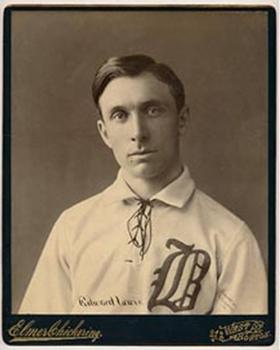July 27, 1901: Boston’s Ted Lewis throws 11 innings of relief in loss to White Sox
 Edward Morgan Lewis was the first player in Boston Red Sox franchise history born outside of North America.1 Ted Lewis was born on Christmas Day 1872 in what was then the market town of Machynlleth, Wales, population slightly over 2,000, set in the lower Dyfi Valley about 10 miles from the coast. It’s also known as the Ancient Capital of Wales.
Edward Morgan Lewis was the first player in Boston Red Sox franchise history born outside of North America.1 Ted Lewis was born on Christmas Day 1872 in what was then the market town of Machynlleth, Wales, population slightly over 2,000, set in the lower Dyfi Valley about 10 miles from the coast. It’s also known as the Ancient Capital of Wales.
Immigrating to the United States at the age of 8, Lewis came to love baseball. He broke into the majors with the National League’s Boston Beaneaters in 1896. Lewis was just 1-4 in that first season but proved to be a 20-game winner both in 1897 (21-12) and 1898 (26-8, leading the league in winning percentage). The Beaneaters won the pennant both years.
Lewis pitched for the Beaneaters the next two years as well, though along the way he earned a master’s degree from Williams College in June 1899.2 He won 17 games in 1899 and 13 in 1900.
Lewis was one of several players from Boston’s National League team lured to play for the brand-new American League’s Boston Americans in 1901. He debuted in the sixth game of the season, on May 2, starting against the Philadelphia Athletics and promptly getting stellar run support from his teammates – the score was 21-2 for Boston after 2½ innings. The Boston Globe noted that Lewis “did not pitch gilt-edge ball by any means.”3 He went the distance but gave up 12 runs. He still got the win, 23-12, over the Athletics.4
Before the Americans’ July 27 game in Chicago, the 28-year-old Lewis was 9-9 with a 4.22 ERA. Eighteen of his 19 appearances had been starts. Three days earlier, on July 24, he had taken the loss in an eight-inning outing against the Milwaukee Brewers. The Americans were second in the AL at 46-29, 3½ games behind Chicago.
Boston’s starting pitcher on July 27 was Fred Mitchell, who had a 5-2 record and a 3.24 ERA in nine appearances.5 Center fielder Billy Hoy led off with a single right past Mitchell and up the middle. Fielder Jones, Chicago’s right fielder, doubled. Second baseman Sam Mertes tripled into the left-field corner to make it 2-0. Frank Isbell, the first baseman, singled in Mertes. Mitchell hit left fielder Herm McFarland with a pitch. Third baseman Fred Hartman sacrificed. Shortstop Frank Shugart singled to drive in Isbell and Mertes
All told, Mitchell gave up five runs before the first inning was over. Manager Jimmy Collins called on Lewis to relieve, starting in the second.
Clark Griffith managed the White Sox. His starter was, like Mitchell, a Massachusetts native, Nixey Callahan. Callahan held Boston scoreless through the first five innings. His White Sox meanwhile built up a 7-0 lead, thanks to two more runs they had added in the bottom of the second “after a couple of errors had given the White Sox two more runs,” reported the Chicago Tribune.6 There was a muffed catch by center fielder Chick Stahl, and catcher Osee Schrecongost’s throw to third base to try to nab a stealing Mertes went wild.
Boston scored four runs in the top of the sixth, on five consecutive singles by Lewis, Dowd, Stahl, Collins, and Freeman, followed by a deep outfield fly by Charlie Hemphill.
The Americans added two more in the seventh, when Shreck singled and Lewis got his second hit, a double. Hoy muffed a catch of a ball hit by Dowd.
Boston tied the game, 7-7, by adding one more run in the top of the eighth on two hits and an error by shortstop Shugart.
Lewis had meanwhile settled in and pitched scoreless ball through the third through the eighth. After the second inning, he allowed only four hits for the remainder of the game.
Double plays got Chicago out of trouble in both the eighth and ninth. The game went into extra innings.
Both Callahan and Lewis continue to pitch well. Neither team scored in the 10th, and neither even got a man on base in the 11th or the 12th. It was apparently not a humdrum stretch, though. The Chicago Tribune said that “the tension on spectators and players was something fearful. In almost every inning there was a sensation that killed runs and prolonged the agony.”7 The Boston Herald called it “one of the most strenuous games ever seen on any diamond.”8
The date had been dubbed “Railway Day” in Chicago, and the game drew a large number of railwaymen, with a couple of thousand fans turned away. It had started at 3:00 P.M. and darkness was approaching, nearly three hours later. There was a sense, as the game moved to the bottom of the 13th, that it might have to be called and go in the books as a tie.9
Leading off for Chicago in the 13th was third baseman Fred Hartman. He hit what the Boston Globe called a “tantalizing little bunt toward third base.”10 Lewis ran over, grabbed it, and threw it to first base, where Lou Criger had just taken over for Buck Freeman.
There’s an apparent discrepancy on how the play unfolded after Lewis’s throw to first. One account reported, “The ball flew on out to the bleachers and just as it reached them took a high bound over the screen and disappeared under the seats.”11
Another account said, “The ball struck the ground before Criger … could get it in his hands. At the same time the ball bounded toward him Hartman made a dive, feet first, toward the bag. So ferocious was his attempt that Criger was knocked completely down, and Hartman fell over him the ball rolling to the bleachers. Hartman, running as if for his life, made the circuit. So dazed was Criger from the contact with Hartman that he was still looking for the ball, even after the run was across the plate.”12
Hartman ran as fast as he could around the bases, even having to fight his way through fans who had flocked onto the field in excitement. “The air was fairly black with cushions, hats were thrown high and smashed with glee, and men who had never seen each other before yesterday found themselves hugging and being hugged because they happened to be sitting and rooting together through the heart-breaking battle,” said the Chicago Tribune,13 dubbing it a “home run” error.
As of 2025, Lewis’s 11 innings thrown in relief remain a Red Sox franchise record, though matched by another pitcher – Babe Ruth, on May 15, 1919 – also against the White Sox in Chicago. The Ruth game ended with a 6-5 Red Sox victory.
Lewis was almost always used as a starter for the 1901 Americans, pitching in relief only five times in 39 appearances. On August 13, he went 13 innings in a complete-game win over Philadelphia. His September 12 start against the Washington Senators was a 10-inning complete game, in a 6-6 tie. Lewis ended the season with 16 wins against 17 losses. The Americans finished second to the White Sox for the first-ever AL pennant.
Author’s Note
As detailed the author’s book Red Sox Threads, “Promptly upon completing his 1901 season pitching for the Boston Americans, [Lewis] started teaching at Columbia. For nine years, he taught elocution and oratory at Williams, later moving to become an English professor as dean of students at Massachusetts Agricultural College. In 1917, Lewis came to know New England poet Robert Frost when they met in the home of university President Meiklejohn at Amherst.
“Frost had a lifelong interest in baseball (he’d been the best pitcher on his high school team in Salem, New Hampshire) and dreamed that he’d pitch in the major leagues, so it was perhaps a foregone conclusion that the two would become friendly. Frost asked Lewis to show him how to throw a curveball, and recalled, ‘He let me into the secret of how he could make a ball behave when his arm was just right. It may sound superstitious to the uninitiated, but he could push a cushion of air ahead of it for it to slide off from, any way it pleased.’ On several occasions, the two enjoyed playing catch.”14
In 1927 Lewis became president of the University of New Hampshire, where he served until his death in 1936.
Acknowledgments
This article was fact-checked by Victoria Monte and copy-edited by Len Levin.
Photo credit: Ted Lewis, Trading Card Database.
Sources
In addition to the sources cited in the Notes, the author consulted Baseball-Reference.com and Retrosheet.org. A good portion of the information here comes from the author’s book Red Sox Threads (Burlington, Massachusetts: Rounder Books, 2008).
https://www.baseball-reference.com/boxes/CHA/CHA190107270.shtml
https://www.retrosheet.org/boxesetc/1901/B07270CHA1901.htm
Notes
1 The first player on the team born outside the United States was the starting pitcher in the franchise’s very first game, Canada’s own Win Kellum, who was born Winford Ansley Kellum in Waterford, Ontario, on April 11, 1876. In that very same game – April 26, 1901 – another Canadian played as well: John Bannerman “Larry” McLean, who pinch-hit for his countryman Kellum in the ninth inning, and doubled down the right-field line. He soon scored, but Boston fell short, 10-6. McLean hailed from Fredericton, New Brunswick, born on July 18, 1881.
2 As a student at Williams, Lewis’s SABR biographer Rory Costello wrote, “Lewis faced some most intriguing opponents besides Yale and Harvard. These included the original black pro team, the Cuban Giants, whose trip to the Purple Valley bears further investigation. Another was Louis Sockalexis, then the star center fielder for Holy Cross. A year before his briefly spectacular run with Cleveland, the Penobscot Indian “‘played a phenomenal game, catching and batting balls, whenever and wherever he pleased.’” Rory Costello, “Ted Lewis,” SABR Baseball Biography Project, https://sabr.org/bioproj/person/ted-lewis/. Accessed July 2025.
3 “All One Way,” Boston Globe, May 3, 1901: 8.
4 All but one of the 12 runs were earned. Pete Loos started for the Philadelphia Athletics and gave up five runs in the first inning, the only inning he ever pitched in major-league ball. Bill Bernhard threw the rest of the game for the Athletics, and surrendered the other 18 runs.
5 Mitchell was from Cambridge, Massachusetts, born as Frederick Francis Yapp. As explained in his SABR biography, “An article in the Chicago Daily Tribune said it was Boston Americans manager Jimmy Collins who urged Mitchell to change his name because he feared that the ribbing of the fans could drive him out of baseball.” “Yep, Here’s Yapp,” Chicago Tribune, December 15, 1916: 13; Bill Nowlin, “Fred Mitchell,” SABR Baseball Biography Project, https://sabr.org/bioproj/person/fred-mitchell/. Accessed July 2025.
6 “Defeat Boston in 13 Innings,” Chicago Tribune, July 28, 1901: 17.
7 “Defeat Boston in 13 Innings.”
8 “Defeat at the Finish,” Boston Herald, July 28, 1901: 8.
9 “Defeat Boston in 13 Innings.”
10 “Tough Luck!” Boston Globe, July 28, 1901: 4.
11 “Frenzied Rooters,” Boston Morning Journal, July 28, 1901: 6.
12 “Defeat at the Finish.”
13 “Defeat Boston in 13 Innings.”
14 Red Sox Threads, 86.
Additional Stats
Chicago White Sox 8
Boston Americans 7
13 innings
South Side Park
Chicago, IL
Box Score + PBP:
Corrections? Additions?
If you can help us improve this game story, contact us.

